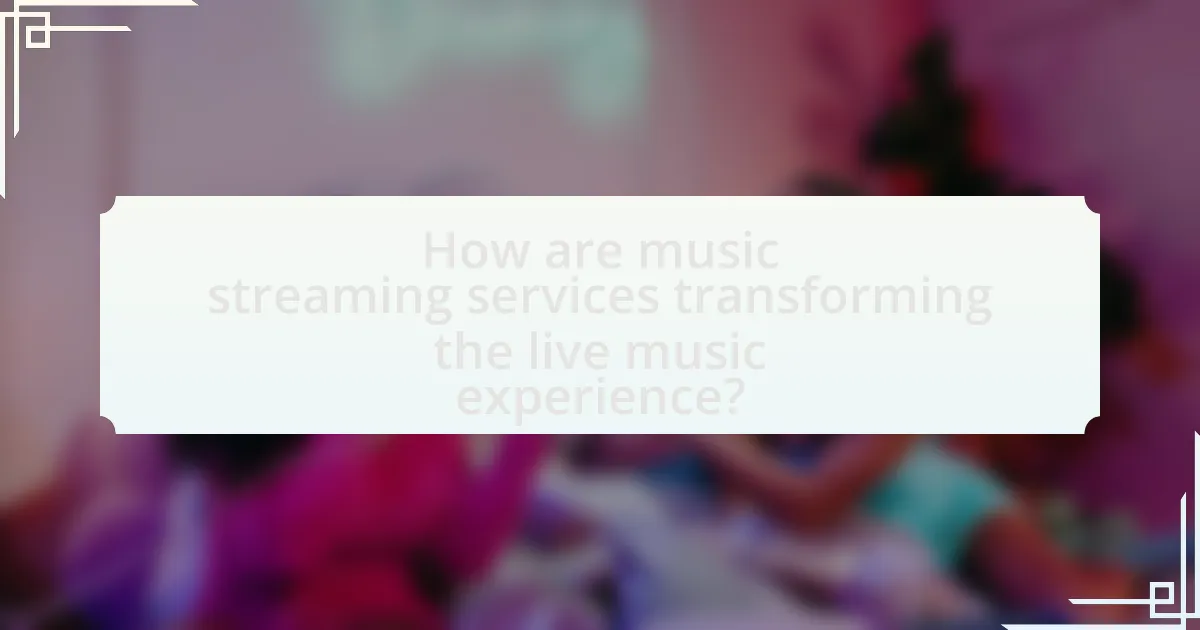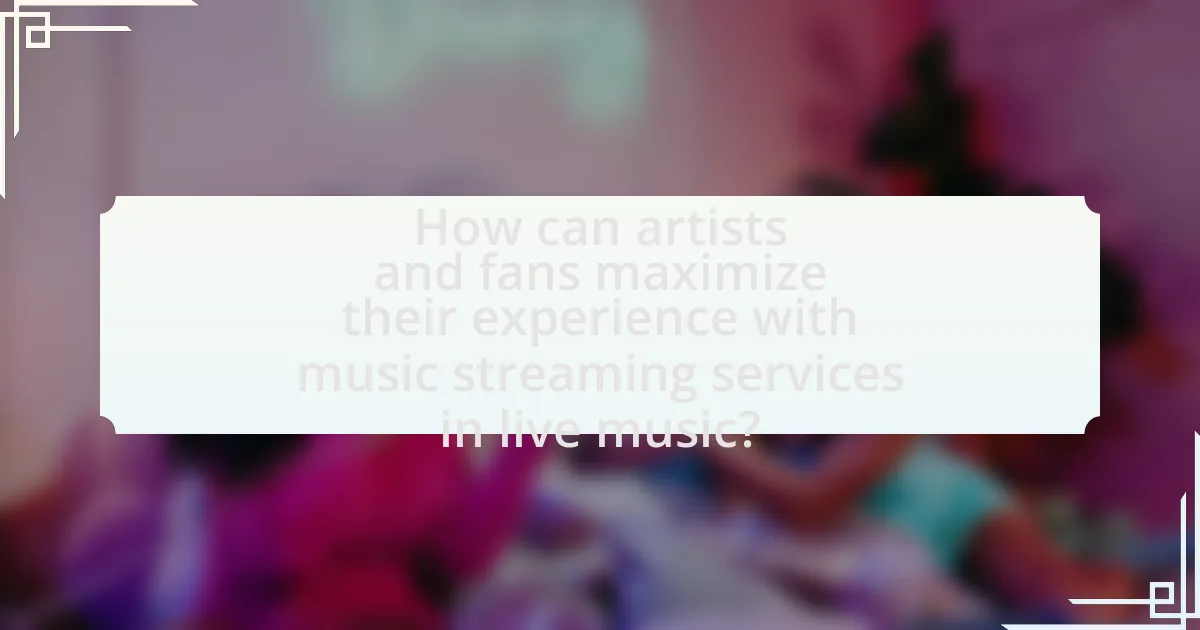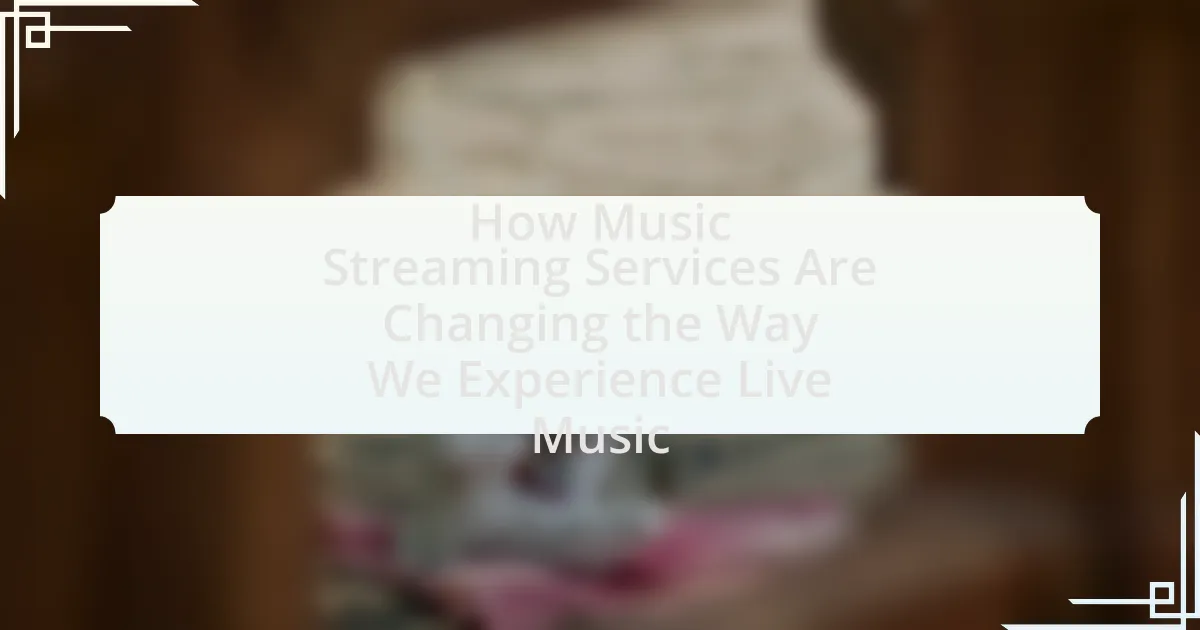Music streaming services are significantly transforming the live music experience by enhancing accessibility, audience engagement, and artist exposure. These platforms facilitate the discovery of new artists and tracks, leading to increased attendance at live events through features like concert notifications and exclusive live-streamed performances. While streaming services broaden audience reach and create new revenue streams, they also present challenges such as reduced ticket sales and complex licensing issues. The article explores the impact of streaming on live music, including how artists can leverage these platforms to engage fans, the technological advancements driven by streaming, and the financial implications for both artists and audiences.

How are music streaming services transforming the live music experience?
Music streaming services are transforming the live music experience by enhancing accessibility and engagement for audiences. These platforms allow fans to discover new artists and tracks, leading to increased attendance at live events. For instance, Spotify’s concert integration feature notifies users of nearby shows based on their listening habits, directly linking streaming activity to live performance attendance. Additionally, services like Apple Music and Tidal offer exclusive live-streamed concerts, enabling fans to experience performances remotely, which broadens the audience reach beyond geographical limitations. This shift not only increases artist visibility but also creates new revenue streams through ticket sales and merchandise linked to streaming data.
What role do music streaming services play in live music accessibility?
Music streaming services significantly enhance live music accessibility by providing users with the ability to discover, listen to, and engage with live performances from anywhere. These platforms often feature live concert recordings, virtual events, and exclusive live sessions, allowing audiences who may not be able to attend in person to experience performances in real-time or on-demand. For instance, services like Spotify and Apple Music have partnered with artists to stream live concerts, reaching millions of listeners globally. This democratization of access enables fans from diverse geographical locations and economic backgrounds to enjoy live music experiences that they might otherwise miss.
How do streaming platforms enhance audience reach for live events?
Streaming platforms enhance audience reach for live events by providing global accessibility and real-time engagement. These platforms allow users to watch live events from anywhere in the world, significantly increasing the potential audience size beyond physical venue limitations. For instance, platforms like YouTube Live and Twitch have hosted events that attracted millions of viewers simultaneously, demonstrating their ability to connect artists with a vast audience. Additionally, features such as chat interactions and social media integration foster community engagement, further amplifying the event’s reach and impact.
What impact do streaming services have on ticket sales for live performances?
Streaming services negatively impact ticket sales for live performances by providing easy access to recorded music, which can reduce the perceived value of attending live events. A study by the University of Southern California found that as streaming consumption increases, attendance at live concerts tends to decline, particularly among younger audiences who may prefer the convenience of streaming over the experience of live shows. Additionally, data from Pollstar indicates that while overall concert attendance has grown, the growth rate has slowed in markets where streaming services are most popular, suggesting a correlation between streaming and reduced ticket sales.
How do music streaming services influence artist exposure during live events?
Music streaming services significantly enhance artist exposure during live events by providing platforms for artists to reach wider audiences through curated playlists and algorithm-driven recommendations. These services, such as Spotify and Apple Music, allow artists to showcase their music to potential fans who may attend live performances, increasing ticket sales and audience engagement. For instance, a study by the University of Southern California found that artists featured on popular playlists experienced a 30% increase in concert attendance. This demonstrates that music streaming services not only promote artists’ music but also directly impact their visibility and success in live settings.
What benefits do emerging artists gain from streaming platforms during live shows?
Emerging artists gain increased visibility and audience engagement from streaming platforms during live shows. These platforms allow artists to reach a global audience, enabling them to promote their performances and connect with fans in real-time. For instance, platforms like Spotify and YouTube Music often feature live streams, which can attract viewers who may not have been aware of the artist otherwise. Additionally, data from a 2021 report by the International Federation of the Phonographic Industry indicates that 70% of music listeners discover new artists through streaming services, highlighting the role of these platforms in expanding an artist’s reach during live performances.
How do established artists leverage streaming services to enhance their live performances?
Established artists leverage streaming services to enhance their live performances by utilizing data analytics to understand audience preferences and engagement patterns. By analyzing streaming metrics, such as song popularity and listener demographics, artists can tailor their setlists to include tracks that resonate most with their audience, thereby increasing audience satisfaction and engagement during live shows. For instance, artists like Taylor Swift and Ed Sheeran have successfully used insights from platforms like Spotify to curate performances that reflect their listeners’ tastes, leading to sold-out shows and positive reviews. This strategic use of streaming data not only optimizes the live experience but also strengthens the connection between artists and their fans.
What technological advancements are driven by music streaming services in live music?
Music streaming services drive several technological advancements in live music, including enhanced ticketing systems, virtual reality experiences, and data analytics for audience engagement. Enhanced ticketing systems utilize blockchain technology to ensure secure transactions and prevent fraud, improving the overall ticket purchasing experience. Virtual reality experiences allow fans to attend live concerts remotely, providing immersive environments that replicate the live experience. Data analytics tools enable artists and promoters to analyze listener behavior and preferences, optimizing setlists and marketing strategies for better audience engagement. These advancements collectively transform how audiences interact with live music events.
How do live streaming technologies integrate with traditional concert experiences?
Live streaming technologies enhance traditional concert experiences by allowing remote audiences to participate in real-time performances. This integration enables artists to reach a broader audience beyond physical venue limitations, as evidenced by events like the 2020 Global Citizen concert, which attracted over 20 million viewers online. Additionally, live streaming provides interactive features such as live chats and virtual meet-and-greets, fostering engagement between artists and fans. The combination of in-person attendance and online streaming creates a hybrid model that maximizes audience reach and enhances the overall concert experience.
What innovations in sound and visuals are influenced by streaming services?
Streaming services have significantly influenced innovations in sound and visuals by promoting high-resolution audio formats and immersive visual experiences. For instance, platforms like Tidal and Amazon Music HD offer lossless audio streaming, enhancing sound quality for listeners. Additionally, services such as YouTube and Twitch have integrated live streaming features that utilize advanced video technologies, including 4K resolution and augmented reality, to create engaging visual experiences during live performances. These innovations are supported by the increasing demand for superior audio-visual quality among consumers, as evidenced by a report from the International Federation of the Phonographic Industry, which highlights a growing trend in high-fidelity music consumption.

What challenges do music streaming services face in the live music sector?
Music streaming services face significant challenges in the live music sector, primarily due to competition with traditional ticketing platforms and the need for exclusive content. These services often struggle to secure partnerships with venues and artists, as established ticketing companies have long-standing relationships and brand loyalty. Additionally, the streaming platforms must navigate complex licensing agreements and revenue-sharing models that can limit their ability to profit from live events. For instance, according to a report by the International Music Summit, live music revenue reached $30 billion in 2019, highlighting the lucrative nature of this sector and the intense competition streaming services face to capture a share of that market.
How do copyright issues affect live streaming of music events?
Copyright issues significantly impact the live streaming of music events by requiring permissions and licenses from copyright holders. When a music event is streamed live, the performance is considered a public display of copyrighted material, necessitating the acquisition of rights from songwriters, publishers, and record labels. Failure to secure these rights can lead to legal repercussions, including fines and the removal of content from streaming platforms. For instance, the U.S. Copyright Act mandates that any public performance of copyrighted music must be licensed, which has led many platforms to implement strict compliance measures to avoid infringement.
What are the legal implications for artists and streaming platforms?
The legal implications for artists and streaming platforms primarily revolve around copyright laws, licensing agreements, and revenue distribution. Artists must ensure their music is protected under copyright to prevent unauthorized use, while streaming platforms are required to obtain licenses to legally stream music. For instance, the Music Modernization Act in the United States mandates that streaming services pay mechanical royalties to songwriters and publishers, ensuring artists receive compensation for their work. Additionally, disputes over revenue sharing models can lead to legal challenges, as seen in cases where artists argue that streaming platforms do not provide fair compensation relative to the revenue generated from their music.
How do licensing agreements impact the availability of live performances online?
Licensing agreements significantly restrict the availability of live performances online by determining the rights and permissions required for streaming content. These agreements often stipulate specific terms regarding which performances can be broadcast, the platforms that can host them, and the geographical regions where they can be accessed. For instance, a study by the International Federation of the Phonographic Industry (IFPI) highlights that licensing complexities can lead to delays or outright bans on streaming certain live events, as rights holders seek to protect their intellectual property and revenue streams. Consequently, the intricacies of these agreements can limit audience access to live performances, impacting how fans experience music in the digital age.
What are the financial challenges for artists using streaming services for live music?
Artists face significant financial challenges when using streaming services for live music, primarily due to low payout rates and high competition. Streaming platforms typically offer minimal compensation per stream, averaging around $0.003 to $0.005 per play, which makes it difficult for artists to earn a sustainable income from their music. Additionally, the oversaturation of content on these platforms leads to fierce competition, making it harder for individual artists to gain visibility and attract paying audiences. This financial strain is compounded by the costs associated with live performances, such as venue rentals, equipment, and promotion, which can further diminish potential earnings.
How do revenue models differ between traditional live performances and streaming?
Revenue models for traditional live performances primarily rely on ticket sales, merchandise, and sponsorships, while streaming services generate revenue through subscription fees, advertising, and licensing deals. Traditional live performances often see a significant portion of their income from direct audience engagement, with ticket sales being a primary source; for example, in 2019, the global live music market was valued at approximately $28 billion. In contrast, streaming platforms like Spotify and Apple Music monetize their content through monthly subscriptions and ad revenues, with Spotify reporting over 400 million users, including 180 million paid subscribers as of 2021. This fundamental difference highlights how traditional performances depend on physical attendance and immediate sales, whereas streaming models leverage digital access and recurring revenue streams.
What are the implications of streaming royalties on live music earnings?
Streaming royalties significantly impact live music earnings by reducing the overall revenue artists can generate from performances. As streaming platforms like Spotify and Apple Music dominate music consumption, artists often rely on these services for income, which typically offers lower payouts compared to live performances. For instance, a study by the Music Industry Research Association found that artists earn an average of $0.003 to $0.005 per stream, which is substantially less than the earnings from ticket sales and merchandise at live shows. Consequently, many artists may prioritize streaming over live performances, potentially leading to fewer live events and diminished audience engagement. This shift alters the traditional revenue model, making it essential for artists to adapt their strategies to maintain financial viability in a landscape increasingly influenced by streaming royalties.

How can artists and fans maximize their experience with music streaming services in live music?
Artists and fans can maximize their experience with music streaming services in live music by utilizing features such as live streaming, interactive playlists, and social sharing. Live streaming allows artists to reach a global audience in real-time, enhancing fan engagement and accessibility. For instance, platforms like Twitch and YouTube Live enable artists to perform live concerts, which fans can attend virtually from anywhere, thus expanding their reach beyond physical venues.
Additionally, interactive playlists allow fans to curate their own experiences by selecting songs they want to hear during live events, fostering a sense of participation. Social sharing features enable fans to share their experiences on social media, creating a community around the event and increasing visibility for the artist. According to a report by the International Federation of the Phonographic Industry (IFPI), 70% of music fans engage with artists through social media, highlighting the importance of these interactive elements in enhancing the live music experience.
What strategies can artists use to engage fans through streaming during live events?
Artists can engage fans through streaming during live events by utilizing interactive features such as live chats, polls, and Q&A sessions. These strategies foster real-time communication and create a sense of community among viewers. For instance, platforms like Twitch and YouTube Live allow artists to respond to fan comments instantly, enhancing the viewer experience. Additionally, incorporating exclusive content, such as behind-the-scenes footage or special guest appearances, can further captivate the audience. According to a report by Nielsen, 70% of fans feel more connected to artists who engage with them during live streams, demonstrating the effectiveness of these strategies in building fan loyalty and enhancing the live music experience.
How can social media integration enhance the live streaming experience?
Social media integration enhances the live streaming experience by facilitating real-time audience interaction and engagement. This integration allows viewers to share their thoughts, reactions, and experiences instantly, creating a communal atmosphere that mimics in-person events. For instance, platforms like Facebook and Twitter enable users to comment, share, and post live updates, which can increase viewer retention and attract a larger audience. According to a study by the Interactive Advertising Bureau, 70% of consumers are more likely to engage with a brand that interacts with them on social media during live events. This statistic underscores the importance of social media in amplifying the reach and impact of live streaming, making it a vital component of modern music experiences.
What role does audience interaction play in live streamed performances?
Audience interaction plays a crucial role in live streamed performances by enhancing engagement and creating a sense of community among viewers. This interaction allows audiences to participate in real-time through comments, reactions, and polls, which can influence the performance itself, making it more dynamic and responsive. Research indicates that performances with high levels of audience interaction can lead to increased viewer satisfaction and retention, as evidenced by a study conducted by the University of Southern California, which found that 70% of participants felt more connected to artists when they could interact during live streams. This connection fosters a shared experience, transforming passive viewers into active participants, thereby enriching the overall experience of live music in the digital space.
What tips can fans follow to enhance their experience of live music through streaming services?
Fans can enhance their experience of live music through streaming services by optimizing their audio and video settings for the best quality. Ensuring a stable internet connection is crucial, as buffering can disrupt the experience. Additionally, using high-quality headphones or speakers can significantly improve sound clarity, making the performance more immersive. Engaging with interactive features, such as live chats or social media discussions during the stream, can also enhance the sense of community and connection with other fans. According to a survey by the International Federation of the Phonographic Industry, 70% of music listeners reported that they enjoy live streaming events, indicating a growing trend in fan engagement through these platforms.
How can fans choose the best streaming platforms for live music events?
Fans can choose the best streaming platforms for live music events by evaluating factors such as content variety, user experience, and subscription costs. Platforms like YouTube Live and Twitch offer diverse performances, while services like Veeps and Stageit focus on exclusive artist interactions. User experience is crucial; platforms should provide high-quality streaming and easy navigation. Additionally, fans should consider subscription costs and whether platforms offer free trials or pay-per-view options, as seen with platforms like Live Nation’s Live Streaming. These criteria help fans select platforms that best meet their preferences for live music experiences.
What are the best practices for participating in live streamed concerts?
To effectively participate in live streamed concerts, viewers should ensure a stable internet connection, select an appropriate viewing environment, and engage actively with the performance. A stable internet connection minimizes buffering and interruptions, enhancing the overall experience. Choosing a comfortable and distraction-free environment allows for better focus on the performance, similar to attending a physical concert. Engaging actively, such as participating in chat discussions or using social media to share experiences, fosters a sense of community and connection with other viewers. These practices enhance the enjoyment and immersion of the live streamed concert experience.

Leave a Reply